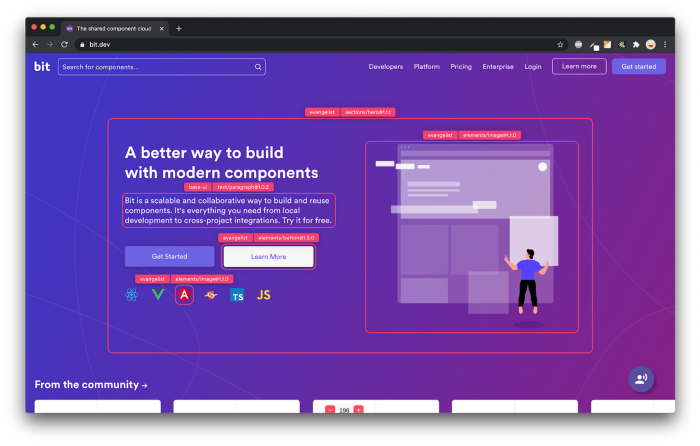

Better SEO in Mobile Apps with Micro Frontends: A Comprehensive Guide
source link: https://blog.bitsrc.io/better-seo-in-mobile-apps-with-micro-frontends-a-comprehensive-guide-1767a7ff2a73
Go to the source link to view the article. You can view the picture content, updated content and better typesetting reading experience. If the link is broken, please click the button below to view the snapshot at that time.

Better SEO in Mobile Apps with Micro Frontends: A Comprehensive Guide

Mobile applications
Micro frontends is a software architecture that involves building applications as a collection of small, independent services, each with its own user interface (UI). This approach can provide several benefits, including improved scalability, enhanced modularity, and better maintainability. In this blog, we will explore how micro frontends can be applied in the context of mobile applications and how to optimize their implementation for search engine optimization (SEO).
One way to implement micro frontends in mobile applications is to use a client-side integration approach, where the micro frontends are integrated into a single page application (SPA) at build time. The SPA is responsible for rendering and updating the UI, allowing for a seamless user experience. This approach can be particularly useful for applications that require fast rendering times or need to support a wide range of devices and platforms. However, it is important to ensure that the SPA is properly optimized for SEO, as search engines may have difficulty crawling and indexing the content if it is not structured correctly. To optimize the SPA for SEO, it may be necessary to use techniques such as server-side rendering, pre-rendering, or dynamic rendering.
Another option is to use a server-side rendering approach, where the micro frontends are rendered on the server and the SPA is responsible for handling interactions and updates. This can be a good option for applications that require fast initial rendering times or need to support older devices that may not perform well with client-side rendering. However, it can also result in a slower overall experience, as the SPA must make additional requests to the server to retrieve updated data. To optimize this approach for SEO, it is important to ensure that the server-side rendering is implemented correctly and that the SPA is able to handle interactions and updates efficiently.
A third approach is to use an API gateway-based architecture, where an API gateway routes requests to the appropriate micro frontend service. This can provide a high level of modularity and flexibility.
Regardless of the approach used, it is important to carefully consider the trade-offs of each option and choose the one that best fits the needs of the application. It may be necessary to use a combination of these approaches to achieve the desired results.
In addition to these technical considerations, it is also important to consider the impact of micro frontends on the development process. Micro frontends can allow teams to work on different parts of the application in parallel, resulting in faster development and deployment times. However, they can also increase the complexity of the overall system, as the different micro frontends must be carefully coordinated and integrated. It may be necessary to adopt new tools and processes to manage the development and deployment of micro frontends effectively.
Overall, micro frontends can be a powerful approach to building mobile applications, providing scalability, modularity, and maintainability. However, it is important to carefully consider the technical and organizational implications of this approach and choose the best option for the specific needs of the application.
Build microfrontends with reusable components
Bit’s open-source tool help 250,000+ devs to build apps with components.
Turn any UI, feature, or page into a reusable component — and share it across your applications. It’s easier to collaborate and build faster.
Split apps into components to make app development easier, and enjoy the best experience for the workflows you want:
→ Micro-Frontends
→ Design System
→ Code-Sharing and reuse
→ Monorepo
Recommend
-
 27
27
Today, we are aware that we should normally not have our whole enterprise in one service, so we split up the enterprise architecture in smaller services, microservices. But we are also starting to realize that we have the sam...
-
 32
32
Brilliant micro-frontends joke :joy: I don’t understand micro-frontends. Yesterday, after coming back from...
-
 39
39
In recent years,microservices have exploded in popularity, with many organisations using this architectural style to avoid the limitations of large, monolithic backends. While much has been written about this style of bu...
-
 9
9
Micro FrontendsMFEs is an architectural style that aims to optimize frontend development. It does so by breaking up the frontend into small and decoupled codebases. These codebases are easier to understand and maintain. The...
-
 8
8
Better JS Logging for Micro-Frontends, Browser, Node Aug 13 ・2 min read ...
-
 5
5
The Future of Micro-FrontendsI have to understand what are the missing pieces of this puzzle and try to picture what would make this architecture approach even betterPhoto by
-
 3
3
Mobile micro frontends are revolutionizing app development Christine Perez Product Marketing Manager
-
 13
13
Micro Frontends in React: A Practical GuideUse micro frontends for building complex modern applications in a scalable way
-
 8
8
-
 2
2
Micro frontends: Shell vs. Micro AppsThe two most common approaches for Micro frontend implementation
About Joyk
Aggregate valuable and interesting links.
Joyk means Joy of geeK
